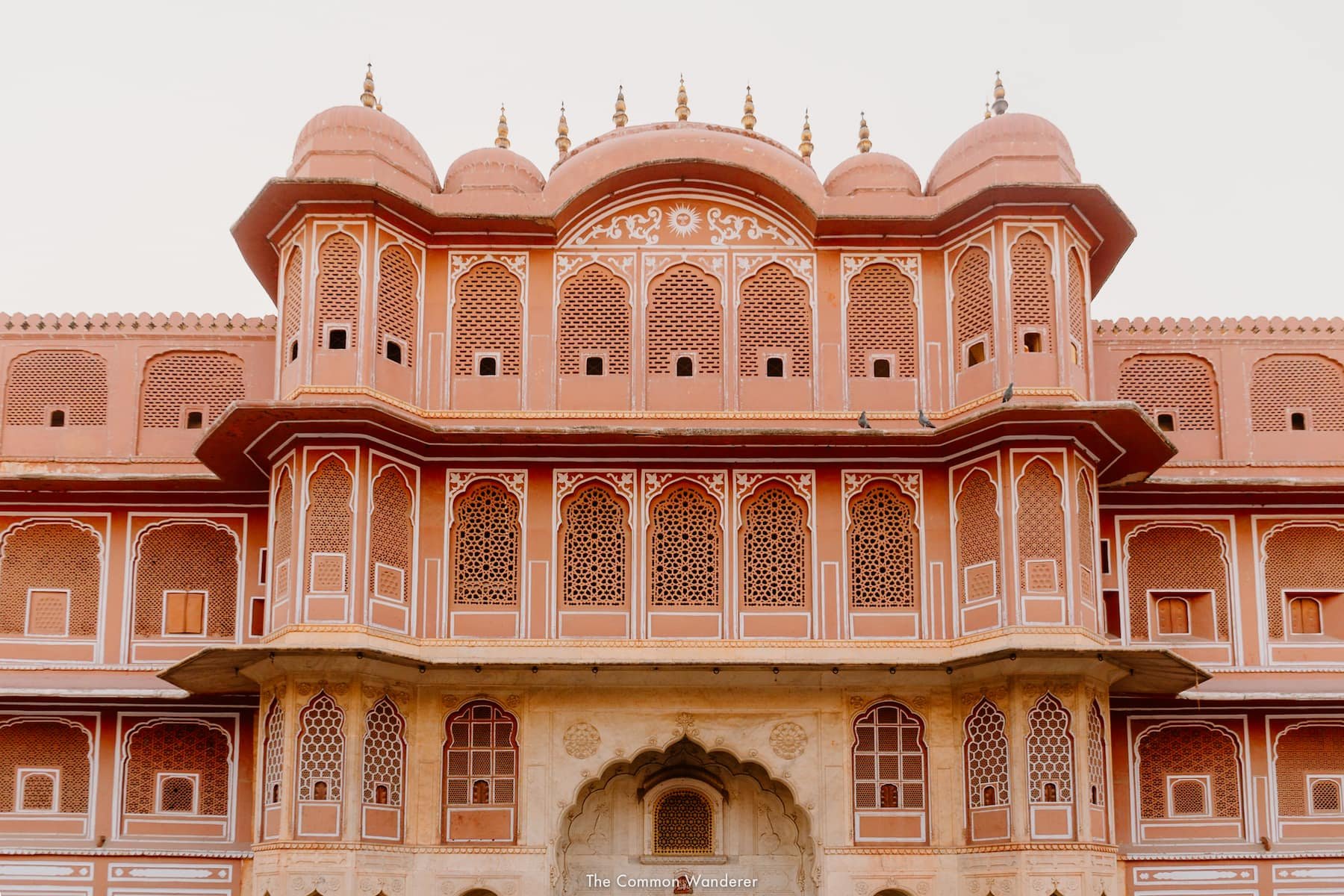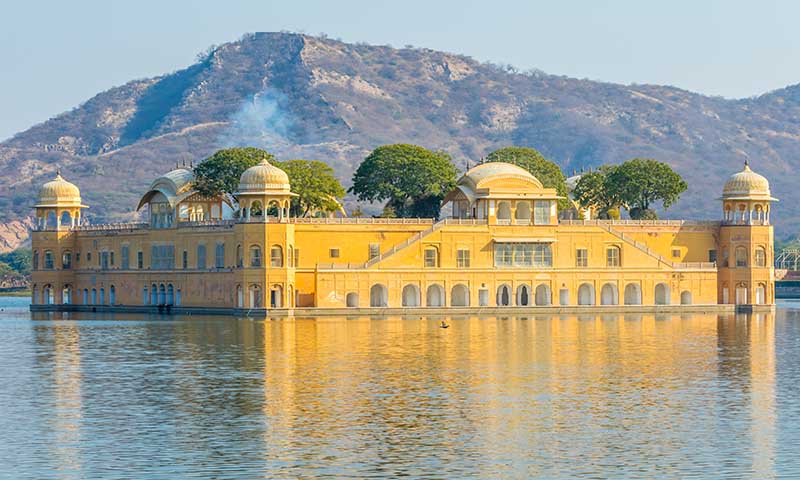Hawa Mahal – A Full Guide to the Palace of Winds in Jaipur
Welcome to Hawa Mahal, the “Palace of Winds,” a mesmerizing architectural gem nestled in the heart of the walled city of Jaipur, India. This iconic structure, standing tall with its honeycomb of intricately latticed windows, weaves a tale of regal splendor and cultural richness. Hawa Mahal invites you to step into its elegant embrace, where the whispers of the past echo through every breeze, inviting you to uncover the secrets within its walls.
Содержание
What is the Hawa Mahal in Jaipur?
The Hawa Mahal, or the “Palace of Winds,” stands as a prominent jewel in the heart of Jaipur, Rajasthan, India. This architectural masterpiece is renowned for its distinctive façade, making it an iconic symbol of the city’s rich heritage.
A Quick Historical Overview
Commissioned in 1799 by Maharaja Sawai Pratap Singh, the Hawa Mahal was designed by Lal Chand Usta in the form of the crown of Lord Krishna. Its purpose was to provide the women of the royal household a discreet view of the city’s bustling life. The structure’s unique architecture also served to enhance natural ventilation, earning it the moniker “Palace of Winds.”
The Exterior
The Hawa Mahal is most celebrated for its exquisite façade, characterized by intricately latticed windows and balconies. These honeycomb-like structures were designed to allow the royal women to observe street festivals and daily life while remaining concealed. The best vantage point to appreciate this marvel is from the nearby series of cafés that offer a panoramic view of the stunning architectural ensemble.
The Interior
While the exterior is the main draw, the interior of the Hawa Mahal is equally fascinating. The palace is a five-story marvel, with the top three stories constituting the façade. The lower two stories house a museum that showcases artifacts and exhibits from Jaipur’s royal history.
Architectural Splendor
The Hawa Mahal’s architectural splendor is not limited to its façade. The palace boasts a rich blend of Rajput and Mughal architectural styles, featuring domes, floral patterns, and intricate carvings. The palace’s unique design ensures a continuous breeze throughout, creating a cool and pleasant environment.

How to get to Hawa Mahal?
Hawa Mahal is located in the central area of Jaipur, next to the City Palace. It’s one of the most central places in Jaipur, and you’ll probably pass by – or close to it – many times during your stay in Jaipur.
The best and cheapest way to reach it is by tuk tuk. Here is the exact location of Hawa Mahal.
Entrance Fee at Hawa Mahal
A ticket to access Hawa Mahal costs 50 INR ($0.60 USD) per person for Indians and 200 INR ($2.60 USD) per person for foreign tourists.
Composite Ticket:
Hawa Mahal is included in the list of places that you can visit with a “Tourist Composite Tickets“. Basically, you can get a composite ticket which gives you access to the following monuments in Jaipur:
- Amber Palace
- Jantar Mantar
- Hawa Mahal
- Nahargarh Fort
- Albert Hall
- Sisodia Garden
- Vidhyadhar Garden
We recommend getting one, as a composite ticket only costs 400 INR ($4.80 USD) per person for Indians and 1000 INR ($12.00 USD) per person for foreigners.
Hawa Mahal Opening Times
Hawa Mahal is open every day from 9:00 AM to 7:00 PM.
Best Viewpoint of Hawa Mahal
The best vantage point to admire the exterior of the Palace of the Winds is undoubtedly the building located right in front of Hawa Mahal. In this structure, you will find a myriad of cafes, jewelries, and other shops intricately mingled with one another.
This is exactly what the building on the opposite side of the road looks like. Climb the stairs and enter the building to access one of the cafes.

Inside, the whole place is a series of narrow staircases and signs indicating cafes in all directions. It’s not something you would typically expect to find inside an historic building in the central area of a state’s capital city, but we’re in India.
A cafè right next to a tattoo studio which also has a lounge terrace and an adjacent jewelry shop. Welcome to the madness of Jaipur!

We randomly picked a cafe and climbed all the way up, to the very top of the building. You obviously have to order something in order to sit in one of the cafes. Luckily prices – although more expensive than the average – are still quite reasonable. We ordered a fresh orange juice which costed 150 INR ($1.80 USD).
Don’t plan on eating a whole meal here or have a fancy breakfast, it’s not worth it. Instead, grab something fresh to drink, take some photos, and leave!

Visiting Hawa Mahal
Soaring 26m (87 feet) high, the Hawa Mahal stands as a pyramid-shaped architectural marvel, comprising five stories adorned with an astonishing 365 windows!
The primary entrance, known as Anandpoli, welcomes visitors into this splendid structure, while the second entrance goes by the name Chandrapoli.
As you step into the second courtyard, a delightful water fountain graces the space. To the south lies Pratap Mandir, the intimate chamber of the Maharaja, while to the north, the Bhojanshala, or Dining Hall, unfolds its charm.
Connected to the City Palace by a passage, Hawa Mahal serves as a regal gateway for royal ladies to witness the grandeur of Teej, Gangaur, and other processions parading through the bustling main market streets.

You can go up to the top floor and even the big tower on the left, but the higher floors get really crowded, and there’s not much to see or do after a short visit.
Some parts of the palace are not well-maintained, and because there are so many people and not many interesting things to check out, spending a lot of time inside Hawa Mahal may not be the best idea.

The windows of Hawa Mahal
The small, colored windows of Hawa Mahal, also known as “Jharokhas,” are a distinctive feature of this architectural masterpiece. These intricately designed windows serve multiple purposes, reflecting both aesthetic and functional considerations:
Ventilation
The primary purpose of the Jharokhas is to facilitate ventilation within the palace. The lattice-like design allows the free flow of air while providing a degree of privacy to the royal women inside. The strategic placement of these windows captures the breeze and helps cool the interior during hot weather.
Observation
The unique design of the windows allows the ladies of the royal court to observe the activities and events taking place in the streets below without being seen themselves. This was particularly important during the times when the strict purdah system was prevalent, and royal women maintained seclusion from public view.
Natural Light
The colored glass used in the Jharokhas serves as a filter for natural light, creating a soft and diffused ambiance inside. This not only enhances the visual appeal but also contributes to energy efficiency by minimizing the need for artificial lighting.

Tips for Visiting
Visit Early: To avoid large crowds and make the most of your experience, consider visiting Hawa Mahal early in the day when it opens. This allows for a more relaxed exploration.
Visit Duration: Plan to spend about 30 minutes inside the palace. It’s a short visit.
Combine with City Palace: Consider combining your visit to Hawa Mahal with the nearby City Palace. Many tourists explore both attractions in one trip as they are in close proximity. Please note that the City Palace is not included in the same composite ticket as the Hawa Mahal.
View from Café: Make sure to visit the viewpoint in front of the Hawa Mahal for the best view.
Best Timing: Avoid the busiest hours if you want to take decent photos inside the Hawa Mahal.
Combined Ticket: Get a combined ticket beforehand. Other ticket offices are much less busy than the ticket counter at Hawa Mahal. If you have to purchase your tickets there, get ready for some long lines!

More things to do in Jaipur
When visiting Jaipur, make sure not to miss these epic spots!
Galta Ji Temple: Explore the serene and historic Galta Ji Temple , known for its stunning architecture and sacred natural springs.
Nahargarh Fort: Immerse yourself in the rich history of Jaipur by visiting Nahargarh Fort , offering panoramic views of the city and an insight into its regal past.
Amer Wall: Witness the grandeur of the Amer Wall , a captivating structure that echoes the architectural splendor of Jaipur. Don’t miss these top activities during your visit!
Читайте далее:





